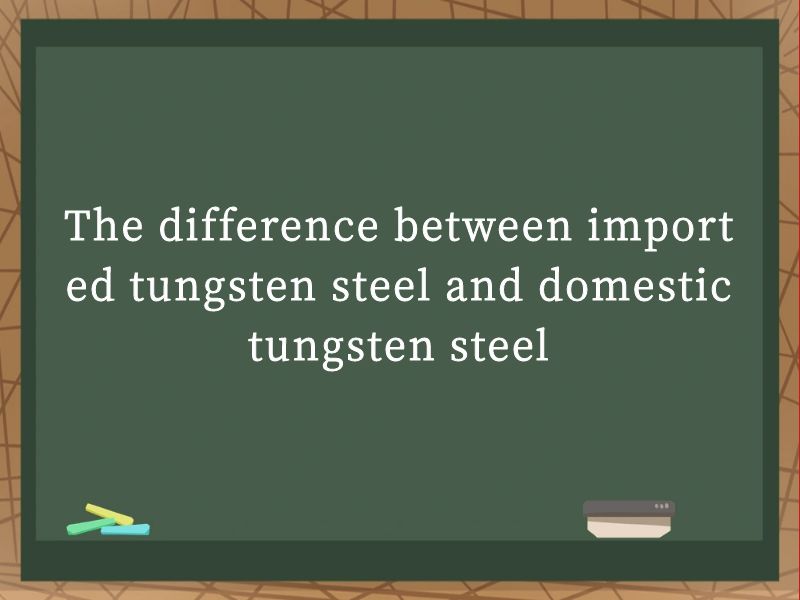JOURNALISM
- NEWS -
|
|
The difference between imported tungsten steel and domestic tungsten steelThe Difference Between Imported Tungsten Steel and Domestic Tungsten Steel.In the realm of materials science, tungsten steel stands out as a remarkable alloy known for its exceptional hardness, durability, and resistance to wear and corrosion. This unique combination of properties makes tungsten steel an indispensable material in various industries, ranging from tooling and machinery to aerospace and electronics. However, when it comes to sourcing tungsten steel, there exists a notable distinction between imported and domestic varieties. This article delves into the nuances that set these two apart, exploring their compositions, manufacturing processes, performance characteristics, and application suitability.
Composition and Manufacturing Tungsten steel, also referred to as tungsten carbide steel, is primarily composed of tungsten carbide (WC) particles embedded in a cobalt (Co) or nickel (Ni) matrix. The proportion of tungsten carbide to the binder metal can vary depending on the desired properties and application. Both imported and domestic tungsten steels adhere to this basic composition, but the devil lies in the details of their manufacturing processes. Imported Tungsten Steel: Imported tungsten steel often originates from countries with a long-standing tradition in metallurgy and advanced manufacturing technologies. These nations typically have access to high-quality raw materials, sophisticated machinery, and stringent quality control measures. The manufacturing process of imported tungsten steel involves: Raw Material Selection: High-purity tungsten powder and carbon black are carefully chosen to ensure consistent quality. Powder Mixing and Granulation: The powders are mixed in precise ratios and then granulated to form uniform particles. Pressing and Sintering: The granulated mixture is pressed into shapes using high-pressure techniques and then sintered at high temperatures to form a solid mass. Finishing: The sintered product undergoes additional processing, such as grinding and polishing, to achieve the desired dimensions and surface finish. The meticulous attention to detail in each step, combined with advanced manufacturing technologies, results in a product that is highly consistent in composition and microstructure, leading to predictable performance. Domestic Tungsten Steel: Domestic tungsten steel production, while following a similar process, may differ in several key aspects due to variations in raw material availability, manufacturing capabilities, and quality control standards. Some points to consider include: Raw Material Variability: Domestic producers might face challenges in accessing high-purity raw materials consistently, leading to potential variations in composition. Equipment and Technology: While domestic facilities are constantly upgrading, there may still be a disparity in the sophistication of equipment compared to international standards. Quality Control: Although quality control measures are in place, they might not be as stringent or consistent as those in countries with more mature manufacturing industries. These factors can result in slight variations in the microstructure and properties of domestic tungsten steel, which may affect its performance in certain applications. Performance Characteristics The performance of tungsten steel is evaluated based on several key characteristics, including hardness, wear resistance, toughness, and corrosion resistance. Let's compare how imported and domestic tungsten steels fare in these aspects. Hardness: Hardness is a measure of a material's resistance to indentation or scratching. Imported tungsten steel, thanks to its precise manufacturing process and high-quality raw materials, tends to exhibit superior hardness. This makes it ideal for applications requiring extreme durability, such as cutting tools and drill bits. Domestic tungsten steel, while still hard, might show slight variations in hardness across different batches or production runs. This can be attributed to the aforementioned differences in raw material quality and manufacturing consistency. Wear Resistance: Wear resistance refers to a material's ability to withstand abrasive or erosive forces. Imported tungsten steel, with its uniform microstructure and high hardness, offers excellent wear resistance. This is particularly beneficial in applications where the material is subjected to constant friction or impact, such as in mining and construction equipment. Domestic tungsten steel, while adequate for many applications, might experience more significant wear over time compared to its imported counterpart. This can lead to shorter service life and increased maintenance requirements. Toughness: Toughness is the ability of a material to absorb energy without fracturing. It's a critical property for applications involving shock or impact loading. Imported tungsten steel, due to its refined microstructure, often demonstrates superior toughness. This makes it suitable for use in high-stress environments, such as aerospace components and heavy machinery. Domestic tungsten steel can be tough, but variations in manufacturing processes might result in some batches being more prone to cracking or fracture under high stress. This necessitates careful selection and testing to ensure suitability for specific applications. Corrosion Resistance: Tungsten steel, in general, has good corrosion resistance due to the inherent properties of tungsten carbide. However, the binder metal (cobalt or nickel) can be susceptible to corrosion in certain environments. Imported tungsten steel, with its precise control over composition and manufacturing, typically offers better corrosion resistance. Domestic tungsten steel might have slightly lower corrosion resistance, especially if the binder metal content or microstructure is not optimally controlled. This could limit its use in highly corrosive environments without additional protective measures. Application Suitability The choice between imported and domestic tungsten steel ultimately depends on the specific application requirements. Here are some considerations for different industries: Tooling Industry: In the tooling industry, where precision and durability are paramount, imported tungsten steel is often preferred for high-end cutting tools, drills, and milling machines. Its superior hardness and wear resistance ensure longer tool life and better performance. Domestic tungsten steel, while suitable for many standard tooling applications, might be more cost-effective for lower-precision or less demanding tasks. Aerospace Industry: The aerospace industry requires materials with exceptional mechanical properties and reliability. Imported tungsten steel, with its consistent quality and superior toughness, is often chosen for critical components such as engine parts and structural elements. Domestic tungsten steel can still be used in certain aerospace applications, but it may require more rigorous testing and qualification to ensure it meets the industry's high standards. Mining and Construction: In the mining and construction industries, equipment is subjected to harsh conditions and heavy wear. Imported tungsten steel, with its excellent wear resistance and durability, is ideal for components like crusher parts, excavator teeth, and drilling bits. Domestic tungsten steel can be used in these applications, but it might require more frequent replacements or maintenance due to its potentially lower wear resistance. Electronics Industry: In the electronics industry, tungsten steel is used for components that require precise machining and corrosion resistance, such as connectors and contacts. Imported tungsten steel, with its superior corrosion resistance and consistent quality, is often the preferred choice. Domestic tungsten steel can be suitable for less critical electronic components or where cost considerations are paramount. The difference between imported tungsten steel and domestic tungsten steel lies in the details of their composition, manufacturing processes, and resulting performance characteristics. Imported tungsten steel, with its high-quality raw materials, advanced manufacturing technologies, and stringent quality control, offers superior hardness, wear resistance, toughness, and corrosion resistance. This makes it ideal for high-performance applications where reliability and durability are crucial. Domestic tungsten steel, while adequate for many applications, might exhibit slight variations in properties due to differences in raw material availability, manufacturing capabilities, and quality control standards. However, it can be a more cost-effective option for less demanding applications or where the benefits of imported steel do not outweigh the additional cost. Ultimately, the choice between imported and domestic tungsten steel should be based on a thorough understanding of the application requirements, performance expectations, and budget constraints. By carefully evaluating these factors, manufacturers and engineers can select the most suitable tungsten steel for their needs, ensuring optimal performance and longevity. |


